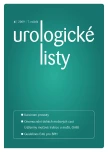SURGICAL ANATOMY OF THE PROSTATE & PELVIC FLOOR FOR THE PERFORMANCE OF RADICAL PROSTATECTOMY & RADICAL CYSTECTOMY: CRITICAL POINTS FOR ACHIEVING THE TRIFECTA OF ONCOLOGIC SAFETY, URINARY CONTROL, AND ERECTILE FUNCTION
Authors:
R. P. Myers
Authors‘ workplace:
Mayo Clinic, Department of Urology, Rochester
Published in:
Urol List 2009; 7(4): 16-19
Overview
Surgical anatomy of the prostate is very complex in part because prostates come in different sizes and shapes, and variable apical configuration that directly affects the ability to achieve a negative surgical margin, transect the urethra in such a way as to maximize functional residual urethral length for urinary continence, and the position of the traversing neurovascular bundles (Figure). The presence or absence of benign prostatic hyperplasia confounds the situation. Other confounding factors include abdominal obesity and adverse pelvimetry.
Key words:
prostate, surgical anatomy, radical prostatectomy, erectile function, urinary kontinence
Sources
1. Benoit G, Droupy S, Quillard J et al. Supra and infralevator neurovascular pathways to the penile corpora cavernosa. J Anat 1999; 195: 605–615.
2. Bishoff JT, Motley G, Optenberg SA et al. Incidence of fecal and urinary incontinence following radical perineal and retropubic prostatectomy in a national population. J Urol 1998; 160(2): 454.
3. Costello AJ, Brooks M, Cole OJ. Anatomic studies of the neurovascular bundle and cavernosal nerves. BJU Int 2004; 94: 1071–1076.
4. Droupy S, Benoit G, Giuliano F et al. Penile arteries in humans: Origin – Distribution – Variations. Surg Radiol Anat 1997; 19(3): 161–167.
5. Hollabaugh RS, Dmochowski RR, Steiner MS. Neuroanatomy of the male rhabdosphincter. Urology 1997; 49(3): 426–434.
6. Karam I, Moudouni S, Droupy S. The structure and innervation of the male urethra: histological and immunohistochemical studies with three-dimensional reconstruction. J Anat 2005; 206(4): 395–403.
7. Kaul S, Bhandari A, Hemal A et al. Robotic radical prostatexctomy with preservation of the prostatic fascia: A feasibility study. Urology 2005; 66(6): 1261–1265.
8. Kiyoshima K, Yokomizu A, Yoshida T et al. Anatomical features of periprostatic tissue and its surroundings: a histological analysis of 79 radical prostatectomy specimens. Jpn J Clin Oncol 2004; 34(8): 463–468.
9. Kourambas J, Angus DG, Hosking P et al. A histological study of Denonvilliers' fascia and its relationship to the neurovascular bundle. Brit J Urol 1998; 82(3): 408–410.
10. Mulhall JP, Slovick R, Hotaling J et al. Erectile dysfunction after radical prostatectomy: Hemodynamic profiles and their correlation with the recovery of erectile function. J Urol 2002; 167(3): 1371–1375.
11. Mulhall JP. Defining and reporting erectile function outcomes after radical prostatectomy: Challenges and Misconceptions J Urol 2009; 181(2): 462–471.
12. Myers RP. Anatomical Open Radical Retropubic Prostatectomy Step by Step. In: Kirby RS, Montorsi F, Smith JS, Gontero P (editors): Radical Prostatectomy: Principles and Practice, London:Informa Healthcare 2007.
13. Myers RP. Localised prostate cancer: Important points of conduct for radical retropubic prostatectomy. European Urology Supplements 2002; 1: 15–19.
14. Myers RP, Villers A. [Chapter 71] Anatomic considerations in radical prostatectomy. In Kirby RS, Partin AW, Feneley M, Kellogg Parsons J, editor(s). Prostate Cancer; principles and practice. Abingdon: Taylor and Francis 2006: 701–713.
15. Myers RP. Detrusor Apron, Associated Vascular Plexus, and Avascular Plane: Relevance to Radical Retropubic Prostatectomy-Anatomic and Surgical Commentary. Urology 2002; 59(4): 472–479.
16. Nelson CP, Montie JE, McGuire EJ et al. Intraoperative nerve stimulation with measurement of urethral sphincter pressure changes during radical retropubic prostatectomy: A feasibility study. J Urol 2003; 169(6): 2225–2228.
17. Nielsen ME, Schaeffer EM, Marschke P et al. High anterior release of the levator fascia improves sexual function following open radical retropubic prostatectomy. J Urol 2008; 180(6): 2557–2564.
18. Paparel P, Akin O, Sandhu JS et al. Recovery of Urinary Continence after Radical Prostatectomy: Association with Urethral Length and Urethral Fibrosis Measured by Preoperative and Postoperative Endorectal Magnetic Resonance Imaging. Eur Urol 2009; 55(3): 629–637.
19. Oelrich TM. The urethral sphincter muscle in the male. Am J Anat 1980; 158(2): 229–246.
20. Rassweiler J. Intrafascial nerve-sparing Lapa-roscopic Radical Prostatectomy: Do we really pre-serve relevant nerve-fibres? Eur Urol 2006; 49(6): 955–957.
21. Rocco F, Carmignani L, Acquati P et al. Restoration of posterior aspect of rhabdosphincter shortens continence time after radical retropubic prostatectomy. J Urol 2006; 175(6): 2201–2206.
22. Salonia A, Gallina A, Zanni G et al. Acceptance of and Discontinuation Rate from Erectile Dysfunction Oral Treatment in Patients following Bilateral Nerve-Sparing Radical Prostatectomy Eur Urol 2008; 53(3): 564–570.
23. Strasser H, Poisel S, Stenzl A et al. Anatomy and innervation of the male urethra, the rhabdosphincter, and the corpora cavernosa. Part II, Lesson 16. 2001; 122–127.
24. Takenaka A, Murakami G, Soga H et al. Anatomical analysis of the neurovascular bundle supplying penile cavernous tissue to ensure a reliable nerve graft after radical prostatectomy. J Urol 2004; 172(3): 1032–1035.
25. Takenaka A, Leung RA, Fujisawa M et al. Anatomy of autonomic nerve component in the male pelvis: the new concept from a perspective for robotic nerve sparing radical prostatectomy. World J Urol 2006; 24(2): 136–143.
26. Takenaka A, Murakami G, Matsubara A et al. Variation in course of cavernous nerve with special reference to details of topographic relationships near prostatic apex: histologic study using male cadavers. Urology 2005; 65(1): 136–142.
27. Walsh PC, Partin AW. Anatomic Radical Retropubic Prostatectomy. In: Wein AJ, Kavoussi LR, Novick AC, Partin AW, Peters CA (eds), Campbell-Walsh Urology, Philadelphia;Saunders, 2007, Vol. III, Section XVI-Prostate: 2956–2978.
Labels
Paediatric urologist UrologyArticle was published in
Urological Journal

2009 Issue 4
Most read in this issue
- Intraoperational course, early complications and functional outcome in robotic-assisted AND OPEN RADICAL PROSTATECTOMY – A COMPARISON
- SURGICAL ANATOMY OF THE PROSTATE & PELVIC FLOOR FOR THE PERFORMANCE OF RADICAL PROSTATECTOMY & RADICAL CYSTECTOMY: CRITICAL POINTS FOR ACHIEVING THE TRIFECTA OF ONCOLOGIC SAFETY, URINARY CONTROL, AND ERECTILE FUNCTION
- ROBOTIC-ASSISTED LAPAROSCOPIC PROSTATECTOMY: A CRITICAL ASSESSMENT OF OUTCOMES
- TRANSITION OF WHOLE GLAND CRYOSURGERY TO FOCAL CRYOABLATION FOR THE TREATMENT OF EARLY STAGE LOCALIZED PROSTATE CANCER
